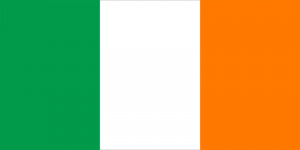Difference between revisions of "Language/Irish/Vocabulary/Basic-Greetings"
m (Quick edit) |
m (Quick edit) |
||
| Line 160: | Line 160: | ||
* [[Language/Irish/Vocabulary/Sports|Sports]] | * [[Language/Irish/Vocabulary/Sports|Sports]] | ||
* [[Language/Irish/Vocabulary/Medicine|Medicine]] | * [[Language/Irish/Vocabulary/Medicine|Medicine]] | ||
<span class='maj'></span> | |||
==Sources== | |||
* [https://www.tripsavvy.com/useful-irish-phrases-and-words-you-might-need-1542712 Common Irish Phrases and Words You Might Need] | |||
* [https://www.bitesize.irish/blog/irish-gaelic-greetings/ Irish Gaelic Greetings (with Video pronunciation!)] | |||
* [https://ling-app.com/ga/irish-greetings/ 20 Easy Irish Greetings You Need To Know - Ling App] | |||
{{Irish-Page-Bottom}} | {{Irish-Page-Bottom}} | ||
Revision as of 21:47, 2 April 2023
Irish, also known as Gaeilge, is the national language of Ireland. It is one of the oldest written languages in Europe, with Gaelic inscriptions dating back to the 4th century. Irish is an important part of Ireland's culture and heritage, and it continues to be spoken by over 1.7 million people worldwide. Whether you are interested in the language because of your Irish heritage, because you plan to visit Ireland, or simply because you love languages, this course will help you learn Irish from scratch. In this lesson, we will be covering the basics of greetings and introductions in Irish.
Basic Greetings
In any language, learning how to say simple greetings like "hello" and "goodbye" is essential. Here are some basic greetings and phrases in Irish that will help you get started:
- Dia dhuit! (Hello!, lit. "God be with you!")
- Dia is Muire dhuit! (Hello!, lit. "God and Mary be with you!")
- Slán! (Goodbye!)
- Slán go fóill! (Goodbye for now! lit. "Safe until we meet again!")
- Conas atá tú? (How are you?)
- Tá mé go maith, go raibh maith agat. (I'm good, thank you.)
- Tá mé go breá, go raibh maith agat. (I'm great, thank you.)
- Tá mé tuirseach (I'm tired)
- Dia linn! (Cheers! lit. "God be with us!")
It's important to note that in Irish, the word order can differ slightly from English. For example, "How are you?" is literally translated in Irish as "How do you find yourself?" (Conas atá tú féin?). This can take some getting used to, but with practice, you'll get the hang of it.
Irish pronunciation can also be tricky at first, but with some practice, you'll be able to pronounce words confidently. A handy tool to help you learn the pronunciation is the International Phonetic Alphabet (IPA). Here are some of the most common sounds in Irish:
- "ch" like in "loch" (IPA: /x/)
- "gh" at the end of a word like in "sláinte" (IPA: /ɣ/)
- "mh" and "bh" at the beginning of a word like in "mhaidin" (IPA: /w/)
- "fh" at the beginning of a word like in "fhios" (silent)
- "sh" like in "sheep" (IPA: /ʃ/)
- "th" like in "think" (IPA: /h/)
Now that we've covered some basic greetings, it's time to practice! Try using some of these phrases the next time you meet someone who speaks Irish.
| Irish | Pronunciation | English |
|---|---|---|
| Dia dhuit! | Dee-ah gwit | Hello! |
| Dia is Muire dhuit! | Dee-ah iss Mwir-eh gwit | Hello! (response when greeted with "Dia dhuit") |
| Slán! | Slawn | Goodbye! |
| Slán go fóill! | Slawn guh fole | Goodbye for now! |
| Conas atá tú? | Kun-us ah-taw too | How are you? |
| Tá mé go maith, go raibh maith agat. | Taw may guh mah, guh rev mah ah-gut | I'm good, thank you. |
Plurals
In English, we indicate plurals by adding an "s" to the end of a word. In Irish, the plural form of a noun is more complex. Generally, the noun will undergo a change in spelling called a "mutation" or "lenition". The most common type of lenition is to add an "h" in front of the first consonant, as shown in this example:
- bean (woman) -> mná (women)
The word for "woman" in Irish is "bean". To form the plural, we add an "h" sound before the "b" and replace the "a" with an "á". The resulting word is "mná", which means "women".
Here are some other examples of pluralized nouns in Irish:
- fear (man) -> fir (men)
- cailín (girl) -> cailíní (girls)
- leabhar (book) -> leabhair (books)
- teach (house) -> tithe (houses)
In general, it's best to learn the plural form of a noun together with the singular, since there are few rules that apply across the board.
Let's practice forming plural nouns with some examples:
| Irish | Pronunciation | English singular | English plural |
|---|---|---|---|
| bean | Bahn | woman | mná (women) |
| fear | Fahr | man | fir (men) |
| cailín | Kal-een | girl | cailíní (girls) |
| leabhar | L-yow-er | book | leabhair (books) |
| teach | Tcha | house | tithe (houses) |
Irish is a fascinating language with a rich history and culture behind it. In the next few lessons, we'll continue building our knowledge of basic vocabulary, grammar, and pronunciation. Get ready to dive in and explore the beauty of the Irish language!
Other Lessons
- Nature and Environment
- City
- Vegetables
- Days of the Week
- At the post office
- Colors
- Education
- Computers
- Sports
- Medicine
Sources
- Common Irish Phrases and Words You Might Need
- Irish Gaelic Greetings (with Video pronunciation!)
- 20 Easy Irish Greetings You Need To Know - Ling App
